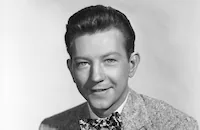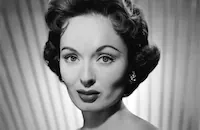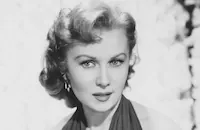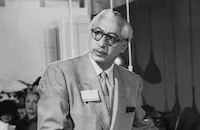The Buster Keaton Story
Cast & Crew
Sidney Sheldon
Donald O'connor
Ann Blyth
Rhonda Fleming
Peter Lorre
Larry Keating
Film Details
Technical Specs

Synopsis
"The Three Keatons," a poor vaudeville family consisting of Joe, his wife Myra and their seven-year-old son Buster, arrive in Fargo, North Dakota on a snowy winter's day in 1904, with dreams of becoming stars. Sixteen years later, however, they are still an opening act. Buster then decides to leave his struggling family and try his luck in Hollywood. Arriving at Famous Studios, Buster sneaks onto the lot, where he tries to demonstrate his comedic abilities to director Kurt Bergner. Though Kurt merely mocks the vaudevillian, Gloria Brent, a casting director, recognizes Buster's talent and convinces Larry Winters, the head of the studio, to take a chance on the brash young man. Though given only a bit part in his first picture, Buster steals the film and is soon offered a studio contract, which he refuses to sign unless he is allowed to direct himself. Winters reluctantly agrees, and in celebration, Buster asks Peggy Courtney, the studio's scheming leading lady, out to dinner. After she laughs at his poor table manners, Buster angrily drags Peggy out of the fancy nightclub, then takes Gloria out to eat at a bar that same night. There, he tells her about his life in vaudeville, how he began his career when he was only three days old and had appeared in his family's "knock-about" act ever since, receiving little, if any, formal education along the way. Later, following the great success of his film, The Criminal , writer-director-star Buster uses his newfound wealth to buy a gigantic thirty-two room Hollywood mansion, then breaks Gloria's heart by telling her that he has bought the estate for Peggy. In turn, Buster's heart is broken when the gold-digging Peggy instead becomes engaged to Duke Alexander Michael David of Bulgaria. Despite the unprecedented success of his film career, an unhappy Buster begins drinking. Wanting a share of his next film's profits, Buster mortgages his mansion in order to pay half the production costs of The Gambler . His film is a box-office flop, however, as The Jazz Singer opens the same night, effectively ending the silent film era. Now financially ruined, Buster is forced to make a sound picture under the studio's terms, which include Kurt as the film's director. Discouraged because his director is more interested in elocution than entertainment, Buster seeks his inspiration from the bottle and the film flops. Meanwhile, Gloria returns from the European trip she had taken to forget about Buster and soon becomes engaged to Tom McAfee, the studio's legal chief. On their wedding day, however, Gloria leaves Tom in order to bail a drunken Buster out of jail. The next morning, a hung-over Buster is informed that he and Gloria are married. Later, Gloria tells Larry that she married Buster in hopes of stopping his self-destructive behavior, but has had little success in that endeavor. Forced to live on his wife's meager savings, the unemployed Buster initially agrees to take a small part in a Famous Studios production, but upon seeing a photograph of himself from his glory days, the still-proud comedian walks out of the studio and directly into a bar. Refused service because he has used up all his credit, Buster goes for a walk and soon finds himself starring in a pickup baseball game, much to the delight of the neighborhood children and himself. The next day, however, Buster falls back into his alcoholic daze after borrowing ten dollars from a fan and getting drunk. In turn, Gloria leaves her husband, feeling her continued presence in his life is not helping matters. Finally forced to sell his mansion, Buster makes a final trip to Famous Studios, where he informs Gloria that he has stopped drinking and decided to go back into vaudeville, having finally realized it is making people laugh, not money or fame, that he enjoys. While performing his new juggling act in a vaudeville house in Fresno, California, Buster is greeted backstage by Gloria. Reunited with his wife, Buster quickly makes her part of his act, stating that he plans to change its name to "The Two Keatons." A pregnant Gloria, however, tells him to make it "The Three Keatons."

Director

Sidney Sheldon
Cast

Donald O'connor

Ann Blyth

Rhonda Fleming

Peter Lorre

Larry Keating

Richard Anderson
Dave Willock
Claire Carleton
Larry White

Jackie Coogan
Dan Seymour
Mike Ross
Nan Martin
Robert Christopher
Richard Aherne
Tim Ryan
Joe Forte
Ralph Dumke
Larry Rio
Constance Cavendish
Ivan Triesault
Pamela Jayson
Keith Richards
Dick Ryan
Guy Wilkerson
Jack Tesler
Jan Bradley
Bobby Faye
Minta Durfee
Lizz Slifer

Benny Rubin
James Stone
Anne Cornwall
Edward Wahrman
Victor Romito
John Benson
Allan Paige
Mary Benoit
June Jocelyn
Richard Gilden
Len Hendry
Eric Alden
Ben Mantz
Len Hendry
Courtland Shepard
Pat Moran
Don Dunning
Paul Francis Derolf
Warren White
Gary Allen
Mickey Finn
Emilie Stevens
Charles Van
Max Power
Bill Meader
Edith Claire
Jody O'connor
John Benson
Cathy Bisutti
Robert E. Bragg
Cherokee Landrum
Dick Alexander
Joe Ploski
Mabel Smaney
Bob Scott
Bobby Barber
Crew
Carl Anderson
Sam Comer
Francisco Day
John P. Fulton
Loyal Griggs
Edith Head
Buster Keaton
Winston Leverett
Nellie Manley
Archie Marshek
Gene Merritt
Ray Moyer
Hal Pereira
Sidney Sheldon
Sidney Sheldon
Robert Smith
Robert Smith
Robert Smith
Wally Westmore
Frank White
Victor Young

Film Details
Technical Specs

Articles
Donald O'Connor, 1925-2003
Born Donald David Dixon O' Connor in Chicago on August 28, 1925, he was raised in an atmosphere of show business. His parents were circus trapeze artists and later vaudeville entertainers, and as soon as young Donald was old enough to walk, he was performing in a variety of dance and stunt routines all across the country. Discovered by a film scout at age 11, he made his film debut with two of his brothers in Melody for Two (1937), and was singled out for a contract by Paramount Pictures. He co-starred with Bing Crosby and Fred MacMurray in Sing, You Sinners (1938) and played juvenile roles in several films, including Huckleberry Finn in Tom Sawyer - Detective (1938) and the title character as a child in Beau Geste (1939).
As O'Connor grew into adolescence, he fared pretty well as a youthful hoofer, dancing up a storm in a string of low-budget, but engaging musicals for Universal Studios (often teamed with the equally vigorous Peggy Ryan) during World War II. Titles like What's Cookin', Get Hep to Love (both 1942), Chip Off the Old Block and Strictly in the Groove (both 1943) made for some fairly innocuous entertainment, but they went a long way in displaying O'Connor's athletic dancing and boyish charm. As an adult, O'Connor struck paydirt again when he starred opposite a talking mule (with a voice supplied by Chill Wills) in the enormously popular Francis (1949). The story about an Army private who discovers that only he can communicate with a talking army mule, proved to be a very profitable hit with kids, and Universal went on to star him in several sequels.
Yet if O'Connor had to stake his claim to cinematic greatness, it would unquestionably be his daringly acrobatic, brazenly funny turn as Cosmo Brown, Gene Kelly's sidekick in the brilliant Singin' in the Rain (1952). Although his self-choreographed routine of "Make "Em Laugh" (which includes a mind-bending series of backflips off the walls) is often singled out as the highlight, in truth, his whole performance is one of the highlights of the film. His deft comic delivery of one-liners, crazy facial expressions (just watch him lampoon the diction teacher in the glorious "Moses Supposes" bit) and exhilarating dance moves (the opening "Fit As a Fiddle" number with Kelly to name just one) throughout the film are just sheer film treats in any critic's book.
After the success of Singin' in the Rain, O'Connor proved that he had enough charisma to command his first starring vehicle, opposite Debbie Reynolds, in the cute musical I Love Melvin (1953). He also found good parts in Call Me Madam (1953), There's No Business Like Show Business (1954), and Anything Goes (1956). Unfortunately, his one attempt at a strong dramatic role, the lead in the weak biopic The Buster Keaton Story (1957) proved to be misstep, and he was panned by the critics.
By the '60s, the popularity of musicals had faded, and O'Connor spent the next several years supporting himself with many dinner theater and nightclub appearances; but just when it looked like we wouldn't see O'Connor's talent shine again on the small or big screen, he found himself in demand at the dawn of the '90s in a string of TV appearances: Murder She Wrote, Tales From the Crypt, Fraser, The Nanny; and movies: Robin Williams' toy-manufacturer father in Toys (1992), a fellow passenger in the Lemmon-Matthau comedy, Out to Sea (1997), that were as welcoming as they were heartening. Survivors include his wife, Gloria; four children, Alicia, Donna, Fred and Kevin; and four grandchildren.
by Michael T. Toole

Donald O'Connor, 1925-2003
Quotes
Trivia
Notes
The opening credits include the following written statement: "This is the sad, happy, loving story of one of the immortals of the silent screen." As pointed out in many contemporary reviews, The Buster Keaton Story is a highly fictionalized account of the famous comedian's life. Unlike the film's depiction, "The Three Keatons" were vaudeville headliners and Keaton entered the motion picture industry due to a chance meeting in 1917 with his old vaudeville friend, Roscoe "Fatty" Arbuckle, who asked Keaton to appear in his short film The Butcher Boy. Keaton continued to work with Arbuckle until 1919, when he began making his own short films. In 1923, the comedian made his first feature film as an independent producer, and later starred in such classics as 1924's The Navigator and 1927's The General (see AFI Catalog of Feature Films, 1921-30). In May 1921, Keaton married Natalie Talmadge, with whom he had two sons, Joseph and Robert. After completing Steamboat Bill, Jr. in 1928, Keaton's production company was absorbed by M-G-M, for which he continued to make films until 1933's What-No Beer? at which time the studio terminated his contract (see AFI Catalog of Feature Films, 1921-30 and 1931-40). After Keaton divorced Talmadge in 1932 and began suffering from alcoholism, his life and career remained in decline until 1940, when the forty-five-year-old comedian married his third wife, twenty-one year old Eleanor Norris. In September 1949, interest in Keaton was renewed when noted critic James Agee's essay "Comedy's Greatest Era" was published in Time. In addition to appearing with his new wife at the "Cirque Medrano" in Paris, Keaton worked regularly in film and television throughout the 1950s and 1960s, receiving a special Academy Award in 1959 "for his unique talents which brought immortal comedies to the screen." The fictional Keaton film The Criminal depicted in The Buster Keaton Story was a reworking of the comedian's 1922 short film Cops, including gags from his 1924 feature film Sherlock, Jr. (see AFI Catalog of Feature Films, 1921-30).
In June 1955, Hollywood Reporter reported that producer-screenwriter Robert Smith had purchased the screen rights to Keaton's story, with the agreement stipulating that the film could be produced independently or in conjunction with a major studio. According to the file on the film in the Paramount Collection at the AMPAS Library, The Buster Keaton Story was originally budgeted at $1,400,000, including $86,000 paid by Forum Productions for the screen rights and screenplay combined. Smith and Sidney Sheldon shared $100,000 for their producing duties, while performers Donald O'Connor, Ann Blyth and Rhonda Fleming received $200,000, $75,000 and $20,000 respectively. Daily Variety reported in January 1956 that O'Connor was being paid $150,000 to star in The Buster Keaton Story, as well as receiving a substantial sum under a second contract with Paramount to be a "consultant" on the producton, working with Smith and Sheldon in developing the Keaton character and assisting in the selection of film excerpts, which were to be gathered from 300 pieces of Keaton's film material. According to Hollywood Reporter, portions of the film were shot on location at the Santa Susana Pass and at the Ray Corrigan Ranch in Simi Valley, CA. Hollywood Reporter news items include Emmett Smith and Bill Walker in the cast, but their appearance in the released film has not been confirmed.
In August 1957, Daily Variety reported that Buster Keaton's former wife Mae Scribbens, now named Jewell Steven and living in New York City, had filed suit against Paramount for $5,000,000, claiming the film depicted her "falsely and maliciously" as it showed her marrying Keaton while he was in a drunken state, and made her appear a "disreputable person of low character and mean design." Modern biographies of Keaton depict Scribbens as a "gold digger" who used her position as a nurse to take advantage of her famous patients, including nightclub comedian Joe E. Lewis, and state that she worked as a prostitute during her brief marriage to Keaton. Unlike the character of "Gloria Brent," Scribbens was a nurse who met Keaton while the comedian was undergoing treatment for his alcoholism. In 1933, she became Keaton's second wife, and the two were divorced in 1935. The final disposition of Scribbens' case against Paramount has not been ascertained.
According to modern sources, writer-producer-director Sheldon decided to do a film based on Keaton's life story due to the great success of M-G-M's 1955 production I'll Cry Tomorrow, which was the story of alcoholic singing star Lillian Roth . In modern interviews, Sheldon stated that after he was brought into the picture by Smith, the two rushed the film into production without a finished script because of O'Connor's limited availability, and that their haste led to the film's critical and financial failure. Although the Keatons were very displeased with the resulting film, the money they made from The Buster Keaton Story was used as to purchase a home in Woodland Hills, CA, where the two lived happily until Keaton's death on February 1, 1966.

Miscellaneous Notes
Released in United States Spring May 1957
VistaVision
Released in United States Spring May 1957













